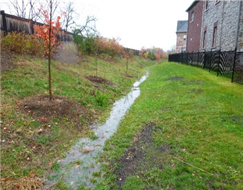Integrating Green Infrastructure into Greenfield Residential Development

Site Maintenance Inspections. Source: CVC (2016)
Courtesy of Credit Valley Conservation
Credit Valley Conservation (CVC) and the City of Brampton have worked collaboratively with a private developer in the design, construction and monitoring of a new residential subdivision, where stormwater is solely managed by low impact development (LID) features. The Wychwood Subdivision has a unique design addressing all stormwater criteria through distributed LID features within municipal right-of-way and residential lots. As a result, land that would otherwise have been reserved for a pond were used to build additional homes. Due to the site’s unique stormwater management design, the Ontario Ministry of the Environment, Conservation and Parks (MECP) included specific monitoring, inspection, and reporting criteria in the site’s Environmental Compliance Approval (ECA).
Compliance and Performance Monitoring:
As part of CVC’s Infrastructure Performance and Risk Assessment Program (IPRA), monitoring and site inspections are completed at Wychwood to evaluate the combined performance of permeable paver driveways, rain gardens, infiltration trenches, oil and grit separators, and a bioswale. Monitoring is focused on evaluating if runoff volume and pollutant load targets are achieved by the stormwater system before discharging to the Credit River.
This evaluation is conducted through:
- Collecting stormwater quantity and quality performance data from a range of precipitation event sizes,
- Conducting site inspections to evaluate the condition of the feature throughout its life cycle, starting at construction, and
- Tracking the frequency and cost of maintenance activities and their impact on performance to inform asset management protocols.
Monitoring Outcomes:
CVC has prepared a mid-term monitoring report highlighting the initial performance findings from the comprehensive monitoring program at Wychwood. Performance monitoring results from Wychwood found that:
- The LID features provided 77% volume reduction for events up to 25 mm.
- An 84% load reduction of TSS, exceeding the site’s specific stormwater management water quality criteria of 80% TSS removal.
- For events greater than 30 mm, peak flows were reduced on average by 74%, with a total volume reduction of 59%.
These findings show LID systems can provide resilience under large and intense rainfall events to support meeting flood control targets and erosion control criteria. Furthermore, limiting peak flow at the source will reduce pressure on downstream infrastructure which is often damaged during larger events with high intensities.

Wychwood Bioswale. Source: CVC (2015)
The monitoring program identified several site constraints impacting the performance of the features. Due to a high groundwater table in one section of the site, the infiltration rates and storage capacity of one of the features is reduced. Additionally, site inspections revealed the need for municipal authorities to regulate impervious landscaping within stormwater features on municipal property and enforce by-laws to protect the features from being included in lot-level landscaping. Changes to the overall site pervious area increased the volume of runoff entering the LID features and impacting observed performance.
Next Steps:
Monitoring results and inspection observation are used to guide and optimize stormwater asset design, develop standard operation procedures and determine the cost of maintenance activities for future development applications.
For more information, visit the project webpage: Low impact Development Performance and Risk Assessment – Wychwood, Brampton
